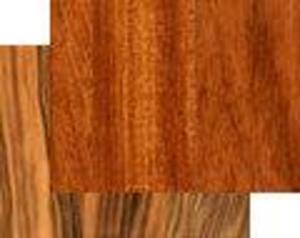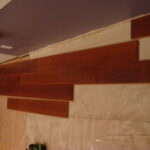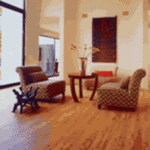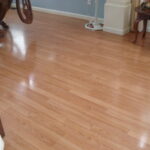There are a million different companies on the market selling hardwood and laminate flooring nowadays. With so many places to buy from and so many types of materials and “great bargains” out there, it is very easy for the average consumer to get caught in a tug of war that could end up costing them thousands of dollars. The hard part for the average consumer is figuring out which salesman is giving them the best information. I can save you the trouble when it comes to that. None of them are. They are simply doing what salesmen do. Convincing you to buy their products so that they can earn themselves a nice commission. The truth is that with a little education and some research you can go into this battle armed with knowledge that can mean the difference between a $5000.00 crappy floor or a $3000.00 high quality floor.
I own a flooring business and have been a Hardwood and Laminate Floor installer for 15 years. I offer to you, free of charge, my many years of experience in the Flooring industry in hopes that someday you can draw upon what you learn here and use it to obtain a floor that will bring you many years of happiness and still leave you feeling like you got a good deal. SO here we go.
There are basically two types of hardwood flooring on the market, Solid Wood Flooring and Engineered Wood Flooring. (Laminates are not wood and will be addressed in a later segment.)
The difference between solid and engineered floors are many, but they can be broken down into four pretty easy to remember categories. Strength/Durability, Construction (how they are made), Cost and Installation.
Solid wood floors are exactly what the name says they are. A single piece of wood that is machined to a certain size. They are almost always tongue and groove. Tongue and groove being the method of attachment, they fit together like a puzzle with the tongue fitting into the groove of the next board, thereby locking them together. The Solid Wood Floors have many advantages over the Engineered Wood Floors, The biggest and most important being their capacity to be refinished over and over. A solid Hardwood floor can be completely resurfaced and brought back to a brand new state many many times.
I have personally refinished hardwood floors in homes that were more than 125 years old. When completed, the floor looked like a brand new. Purchasing a solid wood floor should be a once in a lifetime prospect. Barring severe water or fire damage this Floor will give its owner a lifetime or longer of beauty and durability that is unmatched by any Engineered Flooring.
The downfall of Solid floors are the price and installation cost. The price of solid wood floors can be almost triple that of engineered floors when you add together the price of the wood, the sub-flooring needed, installation and finishing or refinishing. Weighing the fact that this should be the only time in your life that you will have to pay for it though makes it The Best alternative if you can afford it. There are literally hundred of species of flooring that come in thousands of different colors. Choosing the right combination of both can be daunting at times but bringing home large samples and placing them around the rooms, against cabinets and furniture can make all the difference between an eyesore and eyeful.
Durability: Solid wood flooring is unmatched when discussing wood flooring and toughness. Depending on your choice of finishes you can have a floor this is almost impervious to scratches and Dents. Not to say that dragging a piano across the floor will not scratch or dent it because it Will, but everyday use and wear and tear will show little to no effects on the finish.
Installation: The best and strongest way to have a solid wood floor installed is to nail it down. Unless you are dealing with a sub floor that is already wood then you will have to have 3/4 pressure treated plywood shot down to the concrete slab. this is where it gets pricey. Plywood that can stand up to both moisture and bugs, has to be treated and it can be upwards of 40 dollars for a sheet. a sheet typically covers a 32 Sq Ft. area, as they come in 8ft long by 4ft wide sheets. when you start talking about a 3200 sq ft floor that equates to 100 sheets of plywood @ 35 dollars or more. That alone can set you back 4000 dollars. Then the is a waterproof tar paper laid down and stapled to the plywood. This is an added layer of protection for the floor against moisture damage. Only then can the flooring itself be installed. It is a lot more labor intensive and time consuming then the glue down method that almost all engineered floors use, therefore the installers charge a little more money for it.
Solid wood flooring is a job that I do not recommend you attempt to install for yourself. it takes a lot of knowhow to do this the right way and the cost of having to have it removed and replaced because you tried to save a few bucks is NOT worth it. Let us handle it. You will thank yourself when you see it being done.
The other method of installing Solids, is to glue the floor down. I do not recommend this method regardless of what your salesmen or flooring manufacturer says. Solid wood floors are very powerful when they expand and contract. and they all do expand and contract dependent on the climate changes that occur inside your home. I have literally seen glued down wood floors buckle up with such force that they have turned over furniture and a completely full refrigerator. This was a glued down floor. In my Professional opinion leave the glue for engineered floors they are Made to be glued down. Can a glue down solid floor work? Absolutely it can. Do i believe it is worth the risk? I absolutely do not.
When you shop for a solid wood floor look for two things that are very important. the first is the thickness of the wood. Do not buy Solid Flooring that is less than 5/8 of an inch thick. If you are buying a 3/8 inch thick floor you might as well go with an engineered floor. typically though Solid floors are 3/4 of an inch thick.
Second Exotic woods come with hefty price tags. the trick to this is color. Really the thing that sets apart one wood from another is its color. Well I can tell you a secret that the flooring companies don’t want you to know. You can get a white or light red oak floor, and have it stained to match almost any color that a Brazilian Cherry or Brazilian Walnut comes in. Those floors are not always naturally that color anyway and are pre-stained to look that way. They are made from Brazilian cherry tree’s but that shouldn’t make that big of a difference if you can have a white pine floor that cost 35% less to buy made to look exactly like it.
Engineered Flooring.
Engineered hardwood flooring is a very good alternative to Solid wood flooring because of the price of material, installation ease and cost, and wide range of colors, makes and sizes. Engineered hardwood flooring is made with several different layers of wood glued to together and then a layer of the type and color of wood you want is glued to the top of it, giving you the desired finish.
There are three types of installation for Engineered hardwood floors, floating, glued down or nailed/stapled. The most common is the glue down method. This requires you sub floor to be prepared by scarping and leveling it to an almost perfectly flat surface. Without proper preparation the floor will have hollow spots where the wood is not completely attached to the sub floor and can look hilly.
There are several things to look for when purchasing a hardwood floor of the engineered variety. The first and most important thing is the wear layer. The wear layer is the topmost portion if the floor itself. It is the actual part of the board that is Brazilian cherry or walnut etc. the rest of the board may be only regular plywood but this portion is what dictates the wood floors appearance, Grain, color, finish etc. It doesn’t matter if the board is 1/4 of an inch or 1 inch thick; if the wear layer is thin then the floor is Junk. Period. End of story. The wear layer will dictate whether or not the floor can be refinished in the future, how many times it can be refinished, the overall hardness and durability of the finish, the depth to which a scratch can be repaired. Everything that isof importance is right there in that wear layer. Everything else is just plywood and glue.
If the wear layer is an 1/8 of an inch or thinner then the wood floor is Garbage. I don’t care what the price is, what the people tell you it is garbage. Do not buy it. You are looking for a wear layer that is more than 1/8 of an inch thick, the thicker the better. Name brands believe it or not,do not mean anything. Some of the most popular and well known brands of flooring use a very thin wear layer. I will refrain from mentioning them by name but I leave it up to you make a decision based on your Visual inspection of the product.
Typically a decent hardwood floor should cost you around 3.00 a sq ft. If it is 89cents a sq ft. Then bet your butt its garbage. You get what you pay for. However. Just because it is more expensive does not make it better. I know several companies that make Good Quality flooring for under 3.00 a sq ft..
Glue is not included in the price and dependent on which type you go with they range in price from 50 to 200 dollars for four gallons. 4 gallons will normally cover around 200 sq ft of floor. Transitions are not included either. Transitions are the items that are used to connect the hardwood floor to other types of flooring; carpet, tile, laminate, etc. Lastly there is the installation of the floor. As prices between states and installers vary so much I will not quote you a going rate on this.
Floating Floors.
Floating floors are floors that are not permanently attached to the sub floor by means of stapling, nails or glue. There is a thin foam pad laid underneath the floor and the floor is placed on top of the pad. the boards lock together via a snap and click system that holds each board to the other or the seams are glued keeping the boards from separating. The foam pad serves two purposes, one is to create a softer area when walking on the floor and also as a sound suppressor. It keep the floor for making a lot of noise, especially important in an upstairs environment.
There are several downsides to having an Engineered hardwood floor. One is it’s durability. 95% of all engineered hardwood floors come with an aluminum Oxide finish. Big words huh? Well basically that is what gives the floor its shiny appearance. It makes the Floor easy to clean and it looks nice but It is VERY VERY easy to scratch it. It doesn’t take more than a good push with a thumbnail to scratch the finish. These scratches may appear minor to the average person but they are very hard to repair and they add up very quickly. Something as simple as a pebble caught in the tread of your shoe can cause a lot of problems. These floors also tend to dent really easy. For an example of this the next time you are at the local home improvement store swing through their flooring dept. Take a nickel out and press it into the flooring samples. you will see what I mean by dents easy. While you are there scratch it also. the finish isn’t durable at all. If you have children or Pets larger than 15 pounds I recommend that you Do not waste your money on engineered hardwood flooring it just doesn’t stand up to kids or dogs at all.
Laminate flooring.
Laminate flooring is a Very Very good product to have. It looks very much like wood is considerably cheaper to purchase and Is a whole lot more durable then Wood flooring. Yes, even some solids wood floor’s aren’t as tough as laminates. Laminate flooring is made with a very hard compressed dust like substance. I don’t exactly know what it is called sorry. I know that the important thing to look for with laminate flooring is once again the wear layer. The topmost part of the board is simply a picture of an actual wood floor that is glued to the board underneath.
There are really really good laminates out there on the market that have both the look and feel of hardwood flooring. Some of them are so close that even I have to get down and really look to tell the difference. laminates are great for many reasons they stand up to children and large pets. they are very durable and almost impossible to dent. They cost a lot less then all the other wood flooring alternatives. They can stand water or other moisture reasonably well.
The biggest bonus is the ease of installation. With a little guidance and a little practice, the right tools, almost anyone is capable of installing a laminate floor in their home. Once again folks be weary of these 89cents a sq. ft. sales. That is all garbage. If you buy it you will regret it. The installers will hate you for it, it is an uphill battle installing that junk because it doesn’t go together right and it chips very easy on the edges. So If you really want to save some money and end up with a really nice durable floor then laminate is the way to go. If it has to wood but you don’t have a lot of money go with engineered. If you got the cash and really want high quality, durability and classical beauty then solid is the floor for you






